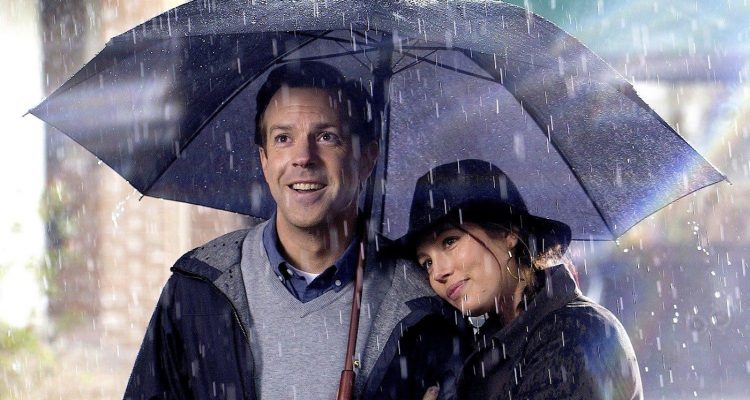Two recent films are bound to come to viewers’ minds while watching Bill Purple’s feature debut “The Devil And The Deep Blue Sea,” one more obvious than the other. The less obvious point of comparison is “Demolition,” Jean-Marc Vallée’s recent seriocomic examination of a man’s eccentric (to put it mildly) expressions of his grief over his wife’s sudden death. Though the grieving husband in Purple’s film, Henry (Jason Sudeikis), doesn’t have the same obsession with destroying physical objects in order to better understand their inner workings as Davis (Jake Gyllenhaal) in Vallée’s film does, Henry — also a successful middle-class type with a penchant for caution that is shattered by his personal loss — similarly finds himself developing a mania that seems crazy to most outside his usual circles: an obsession with helping a homeless girl, Millie (Maisie Williams), fulfill her dream of building a raft to sail to the Azores, in order to escape from an abusive uncle (Jayson Warner Smith). To make the comparison even more pointed, Henry even knocks down a wall in his house like Davis does, though the former stops short of full-on destruction, because he’s only doing it in order to get better wood for Millie’s raft.
A more obvious point of comparison for “The Devil And The Deep Blue Sea” is Benh Zeitlin’s “Beasts Of The Southern Wild.” That film, a Sundance sensation in 2012, attempted to turn the very real traumas New Orleans residents faced during and after Hurricane Katrina into a magical-realist fable of coming-of-age empowerment. Its beautiful cinematography and acting wasn’t enough to offset its political incoherence, however, one that verged on dubious libertarianism especially in its villainous presentation of FEMA-like white figures trying to rescue the refugees of the Louisiana bayou community in which six-year-old Hushpuppy (Quvenzhané Wallis) and her sick father Wink (Dwight Henry) reside.

With its focus on white characters in a post-Katrina New Orleans, no such tricky racial tightrope-walking exists in Purple’s film, save for a black sidekick (Orlando Jones) who is given the oh-so-cute name of “Dumbass.” There aren’t any beasts to be seen here either. But Purple recalls “Beasts Of The Southern Wild” in many other ways. For one thing, there’s Millie’s platitude-ridden voiceover narration, which, like Hushpuppy’s in Zeitlin’s film, attempts to ground “The Devil And The Deep Blue Sea” in the realm of myth, especially with its rampant use of sea and travel metaphors to not only help explain Henry’s irrational behavior, but set out a worldview that preaches openness to life’s unpredictable directions. Heavy-handed Hurricane Katrina references also abound: Henry’s late wife, Penny (Jessica Biel), is described as a “hurricane,” while Millie says her late father “left her behind,” perhaps just like the way the U.S. government could be said to have left some New Orleans residents behind during the storm.
To the “Beasts Of The Southern Wild” formula, Purple and co-writer Robbie Pickering add heaps of saccharine whimsy that even Zeitlin and his Court 13 collaborators were canny enough to sidestep. Having a character named Dumbass is the least of its sins. The eye-rolling whimsy meter goes right off the charts immediately in its characterization of Penny as a free-spirited Manic Pixie Dream Girl who apparently thinks nothing of buying purple — or rather, as Penny is quick to correct Henry, magenta — sneakers for her husband to wear at a major meeting at his architectural day job. But then, there are no real people in “The Devil And The Deep Blue Sea,” only archetypes that we are meant to buy as instantly iconic, whether through exaggerated Southern accents (Biel’s and Williams’) or outsize quirks (Henry’s boss Wendell’s (Paul Reiser) frequent use of Japanese metaphors, Dumbass’ co-worker Pascal’s unintelligible Creole speech that only Dumbass can understand). All of this is made even more insufferable by Justin Timberlake’s goopy score, laying on the cloying strings and piano in order to make everything even more syrupy than it already is.
This penchant for mushy sentimentality sinks whatever good will one might have been willing to grant the film based on its intentions alone. It’s all well and good to try to make a fable about seizing life by the horns and truly living it, with both Penny and Millie intended as symbols of the kind of bold risk-taking that the buttoned-up Henry only finally decides to do after Penny has died. But the characters’ thinly drawn nature creates a void that no amount of insistent feel-good sentiment can fill. Purple’s film aims for mythical uplift, but in trying to inspire all of humanity, he appears to have forsaken the human beings at the heart of his own story. [D+]
Browse through all our coverage of the 2016 Tribeca Film Festival by clicking here.

